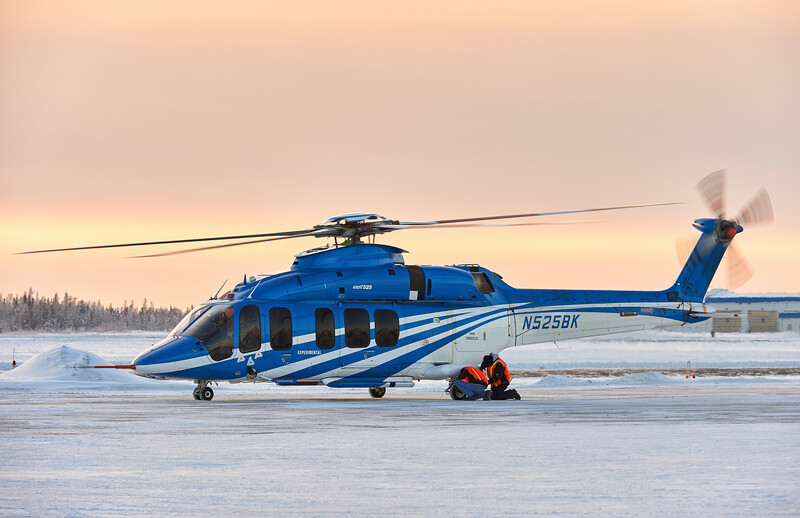Bell still does not have a firm timeline on when the 525 Relentless will receive FAA type certification, but during the wait is pushing for a parallel certification for the aircraft to fly in icy conditions.
Three aircraft are in the hangar at Bell’s Fort Worth, Texas, facility. One is being modified for icing test flights beginning this month in Michigan. Another is the aircraft still performing FAA test flights and a third is the most recent production-representative helicopter. The icing kit will be FAA approved through an amended type certification that will parallel the aircraft certification, according to 525 program director Derek Mookhoek.

“From a program standpoint, we at Bell double down. Not only are we going to continue to press forward on TC, but we are pressing forward with getting into ice and this winter will be our first icing season,” Mookhoek said during a recent media tour of the facility. “We’re going to do that in parallel.”
Typically icing testing is done after a helicopter is certified, Mookhoek said. The reason Bell decided to do icing in a parallel effort is to make the 525 available with the de-icing kit when the first delivery is made. However, development and certification of the icing kit will not “pace” the effort to achieve the base TC, Mookhoek said.
“Rather than having the basic TC and then go into entry into service, and then do a follow on amended TC round icing we want to work that in parallel,” he said.
The progression of ice testing has begun from attaching artificial ice shapes to the nose and other forward-facing surfaces, so engineers can determine how the helicopter will perform with ice on it. It will then fly behind a U.S. army icing tanker and then progress to testing in natural icing environments. The 525 has been to Canada and Colorado for cold-weather testing, but not the official testing for certification icing conditions.
Mookhoek said certification is “closer and closer,” and the company is working with the FAA to get it done in a timely manner. What is left is both flight testing and paperwork — like certification reports.
“Not everything related to certification is just Bell,” Mookhoek said. “We’re continuing to work certification with the FAA and partnering with them to get through it. But the bulk of the work that we have left is being worked with FAA on a daily basis that will drive us to certification.”
The Covid-19 pandemic has not helped the 525 along the path to certification, having delayed meeting with the FAA and flight time in the cockpit.
“We are in a business that is people and for us to go through certification, it takes people being together and that’s in the cockpit,” Mookhoek said. “That’s in reviews of documentation at times, because you can lose the translation of just basic communication through a conference call versus being together in person and getting on a whiteboard — or going out and pointing to exactly what you’re talking about in a hangar.”
As far as Bell’s relationship with the FAA, all is well and there has been no direct fallout from Boeing’s 737 Max fiasco, said chief engineer Josh O’Neil.
“There’s nothing that I could point to, they could say that’s the 737 Max, there’s an additional piece of documentation, there’s an additional report or anything like that, to really point to,” O’Neil said. “There’s another level of due diligence and making sure you’ve got your Is dotted and Ts crossed, but in a sense, that’s a good thing.”

The 525 just came off a three-week U.S. demonstration tour that took it through Texas, Louisiana, Mississippi and Washington, D.C. The aircraft was shown to a dozen oil-and-gas customers, some parapublic operators, a potential government customer and potential foreign customers, according to Tim Evans, director of business development for the 525 program. During the tour, the aircraft performed 50 sorties, carried 400 people, and experienced a 100 percent dispatch rate, Evans said.
“We wanted to put this back in the hands of the customer advisory board who helped us design it, quite frankly,” Evans said. “The overall feedback was extremely positive. And again, these were folks who were part of the customer advisory board so they’re able to see the inputs that they gave the design team in action. . . . I think the most positive feedback we had was the ease in which it was to fly. They were nervous about some of the fly-by-wire in the side stage, but also very pleased with how quickly they were able to adapt.”
Evans said the fickle oil-and-gas market, a major target of the super-medium 525, is “more bullish than it has been.” In the end, customers are waiting for the long-expected helicopter, but Bell cannot provide even those farthest along in order discussions with a solid date, Evans said.
“We really can’t give them a date, a hard date,” he said. “We have several that we’re pretty far along with in discussions and, it’s not a firm date that we can provide. We keep them updated. We provide them as much transparency as we can, but quite frankly, we can’t deliver anything until it’s certified.”









